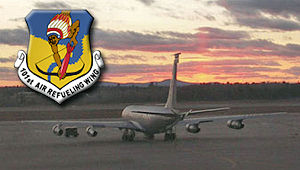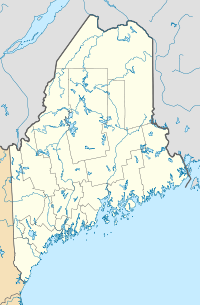- Bangor Air National Guard Base
-
Bangor Air National Guard Base Part of Maine Air National Guard (ANG) Bangor, Maine 
KC-135 of the 101st Air Refueling Wing at Bangor ANGBType Air Force Base Coordinates 44°48′51″N 068°49′51″W / 44.81417°N 68.83083°W Built 1927 In use 1953-Present - For the civil use of this facility and airport information, see Bangor International Airport
Bangor Air National Guard Base is a United States Air Force base, located at Bangor International Airport in Bangor, Maine.
Contents
Overview
The base is the home of the 101st Air Refueling Wing, Maine Air National Guard. The 101st provides 24 hour air and ground refueling for many aircraft whose destination takes them across the Atlantic. Gained by Air Mobility Command, the wing participates around the globe supporting USAF contingency operations such as Operations Noble Eagle, Enduring Freedom, and Iraqi Freedom. The Wing has operated KC-135 Stratotanker aircraft since April 1976 and is part of the Northeast Tanker Task Force (NTTF).
The Northeast Tanker Task Force plans and executes theair refueling portion of fighter and cargo aircraft movements to and from Europe and Southwest Asia. Ground support services contribute to aircraft movement velocityobjectives of Department of Defense and US Allies. Provide logistical and supportservices to the community and State of Maine in the event of natural disasters or asdirected by the Governor.
History
- See Dow Air Force Base, for a complete history prior to 1968
Bangor Air National Guard Base began as "Godfrey Field" in 1927, on land owned by local attorney Edward Rawson Godfrey (1877–1958). Commercial flights began at the field in 1931 under Northeast Airlines. Just prior to the Second World War Godfrey Field was taken over by the US Army Air Corps and was named "Godfrey Army Airfield" (Godfrey AAF).
Under USAAF control, Godfrey AAF was initially placed under the jurisdiction of the 8th Service Group, Air Service Command. Its initial mission was the maintenance and preparation of Lend-Lease aircraft bound for Great Britain, being transported by AAF Ferrying Command to RCAF Stations in Newfoundland. On 28 February 1942, with the United States entering World War II, Dow Field's mission was upgraded to that of being a springboard for the ferrying of B-17 Flying Fortress and, later, B-24 Liberator heavy bombers and other combat aircraft to the European Theater of Operations flying on the Great Circle Route.
On 5 March 1944, jurisdiction of Dow AAF was transferred from Air Service Command to Air Transport Command, being placed under its North Atlantic Wing. Over 8,400 aircraft passed though Dow in 1944, and approximately 2,150 in the last five months of the European conflict in 1945. The base was drawn down during the demobilization in late 1945, and placed in a standby status on 7 May 1946, being made a satellite base of Westover Field, Massachusetts.
During the Cold War, Dow Air Force Base was used by Air Defense Command beginning in 1946 primarily as an interceptor base, and by Strategic Air Command beginning in 1952, for fighters, tankers and B-52 Stratofortress bombers beginning in 1960. The base was inactivated in April 1968 as both a cost-cutting measure and as a result of ICBMs causing a reduction in the number of SAC B-52 wings.
Dow AFB also became the home to the Maine Air National Guard 101st Fighter Group beginning in April 1947. It has operated under different designations at the base for over 60 years, currently the 101st Air Refueling Wing since 1976.
Maine Air National Guard
With the inactivation of Dow AFB in 1968, most of the base was purchased by the city of Bangor and reopened the following year as Bangor International Airport. That portion of Dow AFB not turned over to the city became the basis for the current Air National Guard Base and the Maine Army National Guard's Army Aviation Support Facility.
Under Maine ANG jurisdiction, the airfield was initially the home to the 101st Air Defense Wing of the Maine Air National Guard, an ANG associate of Aerospace Defense Command (ADCOM) 36th Air Division at Topsham AFS, Maine. It operated F-106s until 1969, then changed to F-101B Voodoo interceptors from Dow until 1976. It was reassigned to be an associate unit of SAC, and was renamed the 101st Air Refueling Wing (101st ARW).
The wing was re-equipped with the Boeing KC-135 Stratotanker, which it continues to operate today and shares the civilian airport facilities. Currently, the 101 ARW is operationally gained by the Air Mobility Command (AMC).
Over the horizon radar
About 1985, Air Force Materiel Command re-activated the 776th Radar Squadron at Bangor ANGB. The mission of the squadron was to operate two over the horizon radar (OTH-B) very long-range early warning radar sites. The squadron operated a OTH-B transmitter site at Moscow AFS, Maine, 45°08′14″N 069°48′07″W / 45.13722°N 69.80194°W and a receiver site at Columbia Falls AFS, Maine 44°47′42″N 067°48′41″W / 44.795°N 67.81139°W. These systems were inactivated in 1997, and the unit was inactivated.
Major units assigned
- 101st Fighter Group, 4 April 1947
- Re-designated 101st Fighter Wing, 1 October 1950
- Re-designated 101st Fighter-Interceptor Wing, 1952
- Re-designated 101st Air Defense Wing, December 1960
- Re-designated 101st Air Refueling Wing, 1976–present
Planes based here
- KC-135R Stratotanker (2007–present)MEANG
- KC-135E Stratotanker (1984-2007 MEANG
- KC-135A Stratotanker (1976–1984)MEANG
- F-101B Voodoo (1969–1976)MEANG
- F-102A Delta Dagger (1969) MEANG
- F-89J Scorpion (1959–1969) MEANG
- F-89D Scorpion (1957–1959) MEANG
- F-94A Starfire () MEANG
- F-86D Sabre ()MEANG
- P-51H Mustang ()MEANG
- P-51D Mustang (1950)MEANG
- P-80C Shooting Star (1948–1950)MEANG
- P-47D Thunderbolt (1947–1948)MEANG
References
 This article incorporates public domain material from websites or documents of the Air Force Historical Research Agency.
This article incorporates public domain material from websites or documents of the Air Force Historical Research Agency.- Maurer, Maurer. Air Force Combat Units Of World War II. Washington, DC: U.S. Government Printing Office 1961 (republished 1983, Office of Air Force History, ISBN 0-912799-02-1).
- Ravenstein, Charles A. Air Force Combat Wings Lineage and Honors Histories 1947–1977. Maxwell Air Force Base, Alabama: Office of Air Force History 1984. ISBN 0-912799-12-9.
External links
 United States Air National Guard
United States Air National GuardState and
territorial
unitsAlabama • Alaska • Arizona • Arkansas • California • Colorado • Connecticut • Delaware • District of Columbia • Florida • Georgia • Guam • Hawaii • Idaho • Illinois • Indiana • Iowa • Kansas • Kentucky • Louisiana • Maine • Maryland • Massachusetts • Michigan • Minnesota • Mississippi • Missouri • Montana • Nebraska • Nevada • New Hampshire • New Jersey • New Mexico • New York • North Carolina • North Dakota • Ohio • Oklahoma • Oregon • Pennsylvania • Puerto Rico • Rhode Island • South Carolina • South Dakota • Tennessee • Texas • Utah • Vermont • Virgin Islands • Virginia • Washington • West Virginia • Wisconsin • Wyoming
Flying
groups
and
wingsCompositeAirliftAir RefuelingFighterIntelligenceReconnaissanceSpecialized106th Rescue • 116th Air Control • 129th Rescue • 131st Bomb • 193rd Special Operations • 194th Regional SupportFlying
squadronsAir command and controlAirliftAir refuelingFighterReconnaissanceRescueSpecialized101st Intelligence • 110th Bomb • 113th Air Support Operations • 127th Command and Control • 154th Training • 161st Intelligence • 177th Information Warfare Aggressor • 193rd Special OperationsNon-flying
unitsGroupsAir operationsCombat communicationsSquadronsAir Control116th • 176thAir Operations112thAir Traffic Control270th • 245thCombat CommunicationsEngineering and installation130th • 202d • 205th • 210th • 211th • 212th • 213th • 214th • 215th • 217th • 218th • 219th • 220th • 241st • 243d • 270th • 272dIntelligence117th • 123d • 152d • 194th202d • 203dSpace operationsSpace warning137th • 213thSpecial tacticsMunicipalities and communities of Penobscot County, Maine Cities Towns Alton | Bradford | Bradley | Burlington | Carmel | Charleston | Chester | Clifton | Corinna | Corinth | Dexter | Dixmont | East Millinocket | Eddington | Edinburg | Enfield | Etna | Exeter | Garland | Glenburn | Greenbush | Hampden | Hermon | Holden | Howland | Hudson | Kenduskeag | Lagrange | Lakeville | Lee | Levant | Lincoln | Lowell | Mattawamkeag | Maxfield | Medway | Milford | Millinocket | Mount Chase | Newburgh | Newport | Orono | Orrington | Passadumkeag | Patten | Plymouth | Springfield | Stacyville | Stetson | Veazie | Winn | Woodville
Plantations Unorganized
territoriesArgyle | East Central Penobscot | Kingman | North Penobscot | Prentiss | Twombly | Whitney
CDPs Dexter | East Millinocket | Hampden | Howland | Lincoln | Milford | Millinocket | Newport | Orono
Indian
reservationArmy  FortReservationBailey Island, Cape Elizabeth, Great Chebeague Island, Jewell Island, Long Island, Peaks Island
FortReservationBailey Island, Cape Elizabeth, Great Chebeague Island, Jewell Island, Long Island, Peaks Island
Air Force  BaseStation
BaseStationNavy  Naval Air StationRadio StationShipyardPrison
Naval Air StationRadio StationShipyardPrisonCoast Guard  StationCaribou, Eastport, Jonesport, Rockland, South Portland
StationCaribou, Eastport, Jonesport, Rockland, South PortlandNational Guard  Air National Guard BaseBangorAir National Guard StationSouth PortlandArmy National Guard CampKeyesArmy National Guard ArmoryBangor, Belfast, Calais, Caribou, Fort Kent, Gardiner, Houlton, Lewiston, Norway, Portland, Sanford, Skowhegan, Waterville, WestbrookCategories:
Air National Guard BaseBangorAir National Guard StationSouth PortlandArmy National Guard CampKeyesArmy National Guard ArmoryBangor, Belfast, Calais, Caribou, Fort Kent, Gardiner, Houlton, Lewiston, Norway, Portland, Sanford, Skowhegan, Waterville, WestbrookCategories:- 1927 establishments in the United States
- USAAF First Air Force Tactical Airfields
- USAAF Air Transport Command Airfields - North America
- Strategic Air Command
- Buildings and structures in Bangor, Maine
- Military facilities in Maine
- Facilities of the United States Air National Guard
- Airfields of the United States Army Air Forces in Maine
Wikimedia Foundation. 2010.



